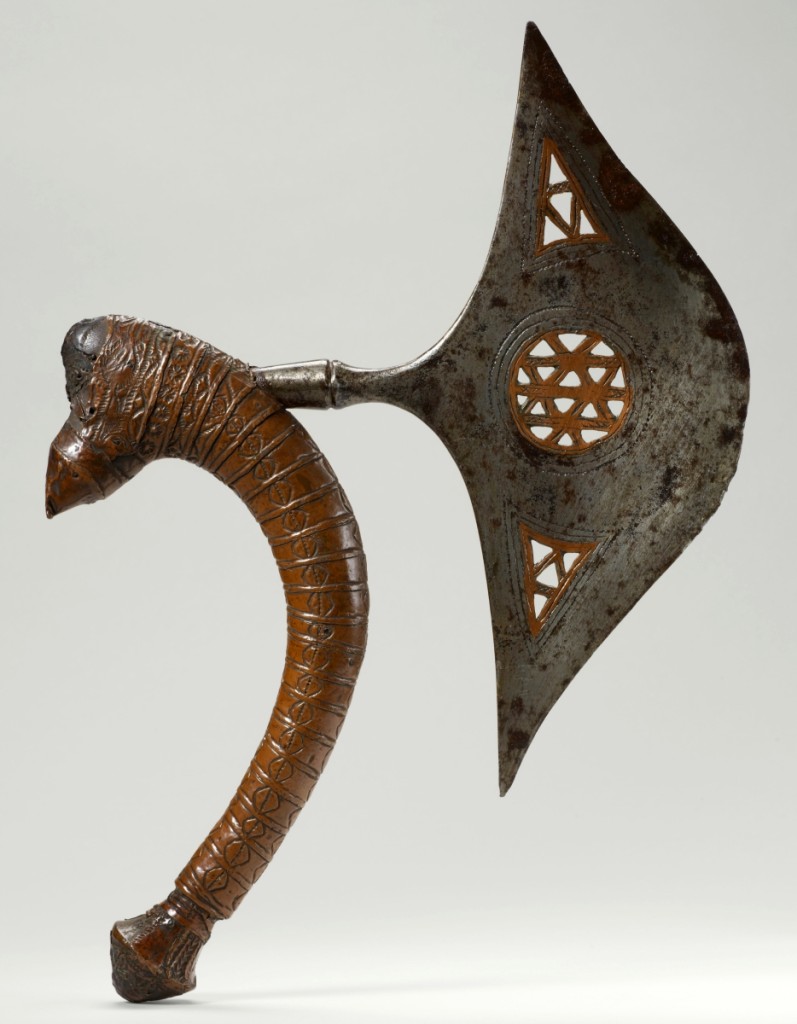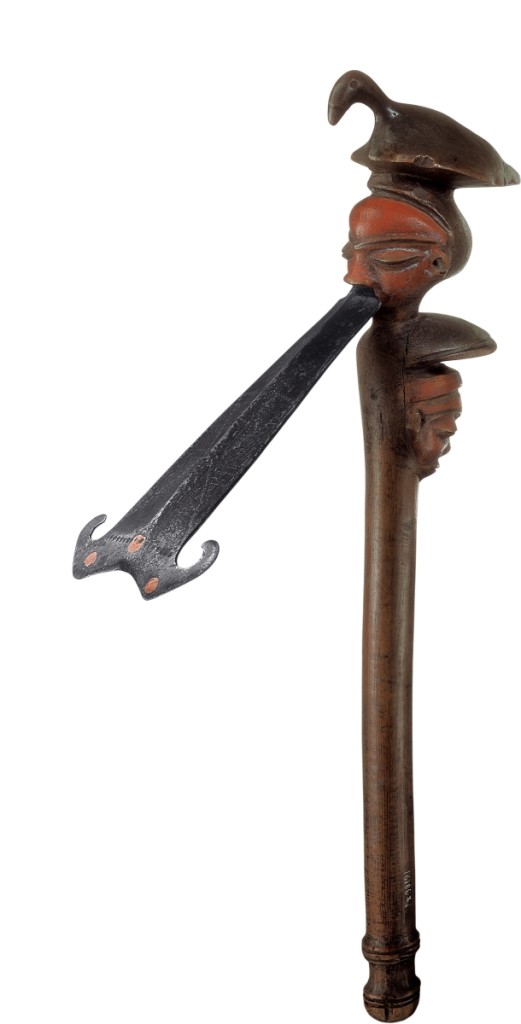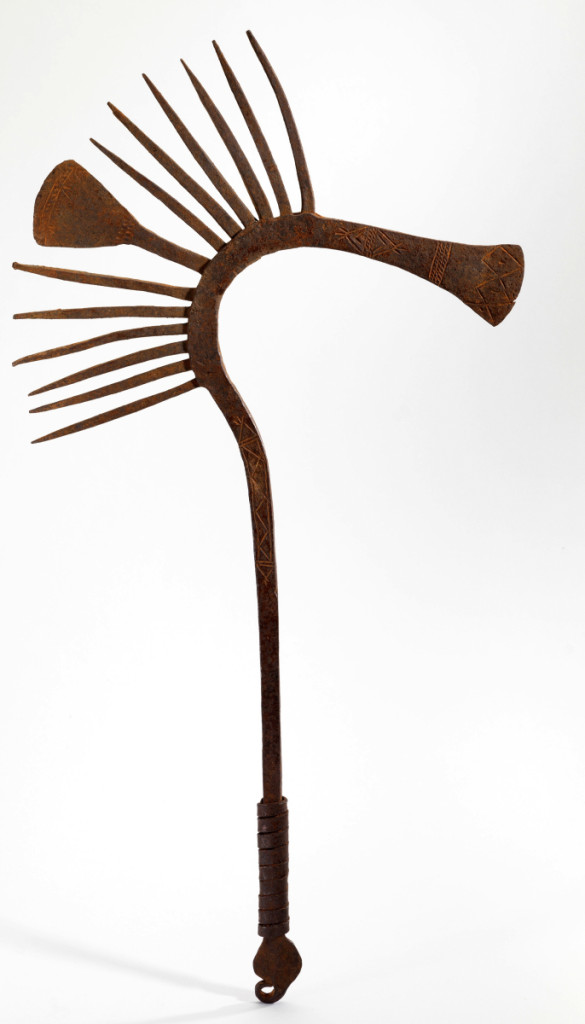
In this single work, the artist employed chiseling, punching, inlaying, chasing, engraving, scoring, raising, wrapping, stamping and embossing, among other techniques. Such a blade added to a blacksmith’s honor and influence in the community, with both owner and artist distinguished every time it was displayed in public. Ceremonial axe by Chokwe or Lunda artist, Democratic Republic of the Congo, early Twentieth Century. Wood, iron, copper. Musée du quai Branly-Jacques Chirac, Paris.
By James D. Balestrieri
WASHINGTON, DC – In one of the many action scenes in the hot new novel by Marlon James, Black Leopard, Red Wolf, the protagonist, known only as Tracker, finds himself in a library on fire, fighting alongside a new ally, Mossi, who is losing a battle of blades with Mazambezi, one of a cohort of prefects sent to make sure the scrolls don’t give up their secrets. Tracker jumps between them:
“Mazambezi swung his sword a hair’s length from my face, and I caught the blade. It shocked the prefect. He pulled his sword to cut my fingers but drew no blood. Mazambezi stood there, stunned. Two swords went straight through his back and came out his belly. Mossi yanked his swords back, and the prefect fell.
“I would ask how, but do I -“
“A Sangoma. An enchantment. He would have killed me with a wooden sword,” I said. (James, p. 339)
Black Leopard, Red Wolf is set in an alternate sub-Saharan Africa, an Africa before contact with Europe, where magical and political powers align and collide. In this world, Tracker – an amalgam of Shaft, Strider, and Snape rolled into one – possesses not one, but three supernatural, superheroic powers: he can see and discern scents over great distances, and, because of a gift from a witch, the Sangoma, he is impervious to iron.
The new exhibition “Striking Iron: The Art of African Blacksmiths,” at the National Museum of African Art at the Smithsonian Institute in Washington, dovetails perfectly with Black Leopard, Red Wolf, illustrating the crucial role of iron in sub-Saharan cultures through the ingenuity and artistry of African blacksmiths from prehistory to the present day. “Striking Iron” exemplifies what all who learn of Tracker’s gift come to know – though some of them learn it the hard way: to be impervious to iron is to come near to godhood, and to go against anyone who has this gift is a one-way ticket to the afterlife.
If we’re being honest, most of us come to African art through Picasso and other early Twentieth Century artists, through works they did that were inspired by African art. Sometimes that brings us to the African works that these artists admired and collected. But these, for the most part, are works that depict the human form in some way: masks, fetishes, statues.
The works in “Striking Iron” are less well known to us, though they are more ubiquitous in Africa: hoes, axes, sickles, currency, spears, throwing knives, staffs, bells. Practical everyday items and implements that, by virtue of the veneration of their utility, are adorned and made ceremonial or repurposed and given new life and immanence. The meaning of an iron hoe transmutes as it becomes a medium of exchange that has value as a work of art, a tool and as a malleable raw material. Thus, the exhibition features spear currency, throwing knife currency, hoe currency, while a pair of hoes, having outlived their usefulness in the fields, are heated, hammered and reshaped into a clapperless bell. That the sound the bell makes recapitulates the sound of hammer on anvil connects the music to its creation, its creator, to the beating of the human heart, and to the earth that yielded its riches. A beautifully rendered sickle in the hand of a Congolese king is a symbol, not only of the ruler’s power over life and death, but of his connection to the fire of the earth, the forge, and the fire that creates human culture. Indeed, sub-Saharan Africa is replete with origin stories of fire stolen from the gods that find their echoes in the Greek Prometheus. In some cultures, a tradition of blacksmith kings lives on to this day.
The process of smelting iron from iron ore in sub-Saharan Africa is ancient and takes several days. The smith, with a group of helpers, often family members, constructs a large furnace made of thick walls of clay, one that can hold a sizable amount of iron ore. The furnace has a narrow chute angling down from the top. This is where the bloom – a mix of refined iron and slag – will emerge. A constant flow of oxygen through the manual manipulation of a built-in bellows, maintains the high heat through the process. In one of a number of fascinating videos, that can also be viewed on the Smithsonian website, Cameroon blacksmith Dokwaza, often called the “Last of the African Iron Masters,” approaches the task of smelting as if it is part girding for battle, part lovemaking and part appeasement of deity. The furnace, giving birth to iron, has a natural feminine aspect. As co-curators Allen F. Roberts and Marla C. Berns write, “the ‘husband’ of the female furnace, glowing red iron was ‘conceived’ as the ‘blood’ and ‘flesh’ of life itself. The ‘delivery’ of an iron bloom was an expression of technology’s potential for material and spiritual transformation, and complex performance arts often accompanied the process.” (African Art, Spring 2018, p. 71)
As an aside, many of these videos are narrated by MacArthur Fellow and master blacksmith, Tom Joyce, who serves as lead curator of the show. His expertise deepens understanding of the works, from the viewpoint both of their creation and their meaning within their respective cultures.
In the video that features Dokwaza, he creates a fetish, pours libations of beer to it, dons ritual battle dress and says to the camera, “Now we go to war.” By the end of the process, when the iron nuggets are separated from the bloom and pounded into ingots, he is exhausted. You can see how the blacksmith might be seen shaman, village elder, priest, even king. Sadly, you can also envision the extraordinary premium placed on captured blacksmiths who were then sold into slavery.

This ceremonial adze, with its tonguelike iron blade, once dignified the left shoulder of a Pende chief who wore it as an emblem of high office when traveling. Never intended to carve wood, the adze represented smooth-cutting diplomacy, straight talk, and efficient negotiation. The bird at the top alludes to the chief’s bird’s-eye view, or oversight, of his domain. In contrast, the calm, masklike face from which the blade emerges is protected by another set of eyes, keeping watch behind him. Adze by Central Pende artist, Democratic Republic of the Congo, early Twentieth Century. Iron, wood, copper, pigment. Felix Collection.
Consider what the blacksmith achieves, how the blacksmith’s art allows humanity to thrive by forging one of humanity’s links in the cycle of life. He takes iron ore from the earth, smelts and refines it, fashions it into hoe, sickle, axe, adze and so on: tools, extensions of the hand and body that facilitate planting, harvesting and hunting the very same land.
In every human endeavor, the purely practical swiftly becomes something else, something more aesthetic. There are many endings to the saying, “Man is the animal that…” One is “Man is the animal that buries its dead.” However, I think it might also be said that “Humans are animals that design.”
The creators of the Luba and Pende adzes in the exhibition, for example, where the blades are long tongues in the heads of carved figures that sit atop their handles, signify the gravity of the owner’s words, the power of his or her speech. As the exhibition text attests, not without humor, “Worn over the shoulder or held in the hand while dancing, such axes or adzes expressed the eloquent or ‘cutting edge’ speech of those privileged to bear them.”
The Mumuye rain vessel, from Nigeria, seems simultaneously to represent lightning that presages rain and shoots of new growth, twisting as they wrest themselves from the earth and reach for the sun. With even more complexity are the altars, or asen, created in Benin, Mali, and among other peoples in West Africa. These asen commemorate the life of the deceased, depicting events and aspects of personality, mixing the spiritual and actual in an easy and beautiful symbiosis.
The red of iron rich earth; the red of fire; the red of blood. Old associations that somehow, in primordial time, prehistoric time – time before history, history recorded, but not before story – these associations led to what must have been an amazing chain of trial and error experiments to wrest iron from iron ore using the very fire that created the ore in the first place. Then to begin to forge it, shape it, fashion it, to see the possibilities of wrought iron to make tools, hunting implements, weapons, musical instruments, ceremonial and aesthetic objects, extensions of hand, power, spirit – this must have been incredible, especially since it occurred in different places at the same time. It’s hard enough to imagine, and impossible to imagine anyone setting this thought process down on paper. Science, art and belief must have collided in an almost cosmic way in a host of like minds, to get from noticing these shared rednesses to the first ingots of refined iron and then to the first objects the first blacksmiths made from them.

Ga’anda iron dance staffs were held aloft during pre-burial rituals, marking the final passage to death. Their form combines the curvature of a long-handled sickle with the flair of an axe blade; a crown of spikes may have symbolically protected the deceased as he or she passed to the world of the ancestors. Finely chiseled triangular designs on the surface repeat the scarification patterns inscribed in the skin of Ga’anda girls upon their transition into adulthood and marriageability. Ritual sickle (wanshipta) by Ga’anda artist, Nigeria, mid-Twentieth Century. Iron. Fowler Museum at UCLA.
You can say the same, I suppose, about any of the raw materials early humans fabricated: wood, clay, stone, copper, bronze. But iron – iron is different. What we have made from the stuff that comprises the core of our planet has grown with us, from iron to steel. Just as iron formed the underpinning of the African civilizations of Benin, Great Zimbabwe and Cameroon, so steel, for better or worse, is the skeletal armature inside contemporary human society. So often in the West, we – and our museums – focus on objects of great value and rarity: gold, ivory, gemstones. But value has many meanings and it is refreshing to see a major exhibition centered around a material we take for granted – one like iron, which is unavoidable, unless the Sangoma has given you Tracker’s gift.
“Striking Iron” was conceived and originated at the Fowler Museum at UCLA. It continues at the Smithsonian through October 20. In November, the exhibition will finish at the Musée du Quai Branly, Jacques Chirac in Paris, home to one of the world’s largest collections of indigenous artworks.
The Smithsonian National Museum of African Art is at 950 Independence Ave SW. For more information, 202-633-4600 or www.africa.si.edu


















